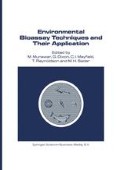Abstract
A bioassay method using the ciliate protozoan Colpidium campylum is presented in a standardized form. The influence of the initial cell concentration on the potassium dichromate EC50 values was determined. Two intercalibration experiments between two laboratories were performed on ten toxicants in two different conditions. The potassium dichromate EC50 determinations performed by eight different people are also presented. All results are discussed in terms of feasibility and reproducibility of the method, fields of application, and limitations.
Access this chapter
Tax calculation will be finalised at checkout
Purchases are for personal use only
Preview
Unable to display preview. Download preview PDF.
References
Berk S. G., A. L. Mills, D. L. Hendricks & R. R. Colwell, 1978. Effect of mercury containing bacteria on mercury tolerance and growth rates of ciliates. Microb. Ecol. 4: 319–330.
Bogaert T., G. Persoone & D. G. Dive, 1982. Research on the development of a short term bioassay for water and soil, with amoebae, starting from cysts. In: H. Leclerc & D. Dive (eds). Acute aquatic ecotoxicological tests: Methodology, standardization and significance. Bull. INSERM, 106: 565 pp.
Bringmann G. & R. Kuhn, 1980. Comparison of toxicity thresholds of water pollutants to bacteria, algae and protozoa in the cell-multiplication inhibition test. Wat. Res. 14: 231–242.
Burbank W. D. & D. H. Spoon, 1967. The use of sessile ciliates collected in plastic Petri dishes for rapid assessment of water pollution. J. Protozool. 14: 739–744.
Dive D. G., 1982. Perspectives d’utilisation des protozoaires en écotoxicologie aquatique. In ’Acute aquatic ecotoxicological test: In: H. Leclerc & D. Dive (eds), Acute aquatic ecotoxicological tests: Methodology, standardization and significance. Bull. INSERM, 106: 273–294.
Dive D. G. & H. Leclerc, 1977. Utilisation du protozoaire cilié Colpidium campylum pour la mesure de la toxicité et de la bioaccumulation des micropolluants: Analyse critique et applications. Envir. Pollut. 14: 169–185.
Dive D. G. & G. Persoone, 1984. Protozoa as test organisms in marine ecotoxicology: Luxury or necessity? In: G. Persoone, E. Jaspers & C. Claus, (eds), Ecotoxicological testing for the marine environment, pp. 281–306. State Univ. Ghent, Belgium.
Dive D. G., G. Persoone & H. Leclerc, 1980. Pesticide toxicity on the ciliate protozoan Colpidium campylum: Possible consequences of the effect of pesticides in the aquatic environment. Ecotoxicol. Envir. Safety 4:129–133.
Dive D. G., N. Pommery, M. Lalande & F. Erb, 1982. Cadmium complexation by humic substances: Chemical and ecotoxicological study with ciliate protozoan Colpidium campylum. Can. Tech. Rep. Fish. Aquat. Sci. 1163: 9–21.
Dive D. G. & L. Rasmussen, 1978. Growth studies on Colpidium campylum under axenic conditions. J. Protozool. 25 (3): 42A.
Dive D. G., P. Vasseur, C. Bel & C. Danoux, 1983. Cadmium-zinc and cadmium-selenium interactions. A comparative study with Colpidium campylum and Photobacte- rium phosphoreum. J. Protozool. 30 (3): 65A-66A.
Dive D. G., P. Vasseur, O. Hanssens & P. J. Gravil, 1988. Studies on interactions between components of electroplating industrial wastes. Can. Tech. Rep. Fish. Aquat. Sci. 1607: 23–34.
Gray J. S. & R. F. Ventilla, 1973. Growth rates of sedimentliving marine protozoans as a toxicity indicator for heavy metals. Ambio 2: 118–120.
Greenberg A. E., J.J. Connors & D. Jenkins (eds), 1980. Standard Methods for the examination of water and wastewaters. Publ. Office, Amer. Publ. Hlth Assoc., 15th Edit.
Parker J. G., 1979. Toxic effects of heavy metals upon cultures of Uronema marinum (Ciliophora, Uronematidae). Ecotoxicol. Envir. Safety 7: 172–178.
Persoone G. & D. Dive, 1978. Toxicity tests on ciliates: A short review. Ecotoxicol. Envir. Safety 2: 105–114.
Persoone G. & G. Uyttersprot, 1975. The influence of inorganic and organic pollutants on the rate of reproduction of a marine hypotrichous ciliate: Euplotes vannus. Rev. Intern. Oceanogr. Méd. 37–38: 125–152.
Plesner P., L. Rasmussen & E. Zeuthen, 1964. Techniques used in the study of synchronousTetrahymena. In: E. Zeuthen (ed.). Synchrony in cell division and growth, pp. 543–563. John Wiley & Sons, New York.
Slabbert J. L., R. Smith & W. S. G. Morgan, 1983. Applications of a Tetrahymena pyriformis bioassay for the rapid detection of toxic substances in water. Water S.A. 3: 81–87.
Vasseur P., D. G. Dive, Z. Sokar & H. Bonnemain, 1988. Interactions between copper and some carbamates used in phytosanitary treatments. Chemosphere 17: 767–782.
Author information
Authors and Affiliations
Editor information
Rights and permissions
Copyright information
© 1989 Springer Science+Business Media Dordrecht
About this paper
Cite this paper
Dive, D. et al. (1989). A bioassay using the measurement of the growth inhibition of a ciliate protozoan: Colpidium campylum Stokes. In: Munawar, M., Dixon, G., Mayfield, C.I., Reynoldson, T., Sadar, M.H. (eds) Environmental Bioassay Techniques and their Application. Developments in Hydrobiology, vol 54. Springer, Dordrecht. https://doi.org/10.1007/978-94-009-1896-2_17
Download citation
DOI: https://doi.org/10.1007/978-94-009-1896-2_17
Publisher Name: Springer, Dordrecht
Print ISBN: 978-94-010-7346-2
Online ISBN: 978-94-009-1896-2
eBook Packages: Springer Book Archive

